Experimental Models of CNS Disease
Experimental Models of CNS Disease
Oral
Oral
Neuro
Thursday, 16 May 2019
| Room 513D-F | 13:45 - 15:45 | Moderators: Sung-Hong Park |
| 13:45 |
1145. 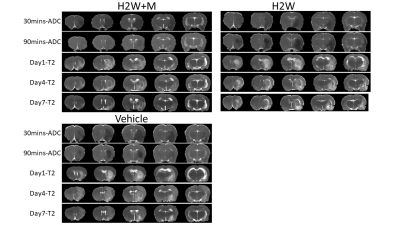 |
Longitudinal multimodal MRI monitoring of a combination therapy using hydrogen enriched water and minocycline in ischemic stroke
zhao jiang, Renee Cattell, Christine Pol, Xin Fang, Dennis Choi, Timothy Duong
Hydrogen or minocycline individually has been shown to be neuroprotective in experimental ischemic stroke. This study evaluated the efficacy of combined hydrogen enriched water with minocycline in an ischemic stroke rat stroke model using longitudinal MRI and behavioral tests using a double-blinded design. We found that the combination therapy reduced lesion volumes, white-matter damage, and behavioral deficits, compared to individual or vehicle treatment alone. These findings suggest that combination of hydrogen water with minocycline has positive therapeutic effects in ischemic stroke.
|
13:57 |
1146. 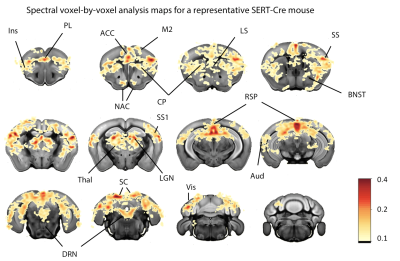 |
Whole-brain functional magnetic resonance imaging of serotonergic neuron optogenetic activation
Madalena Fonseca, Zachary Mainen, Noam Shemesh
Serotonin (5-HT) has been implicated in a variety of brain processes and is a main target of psychoactive drugs, yet we know little about where and how 5-HT acts to ultimately shape behaviour. Here, we optogenetically stimulated serotonergic neurons in the mouse dorsal raphe nucleus (DRN), and mapped the ensuing downstream activity using BOLD fMRI. Furthermore, by pairing 5-HT stimulation with sensory stimuli, we revealed how 5-HT stimulation affects sensory-evoked activity. Our findings highlight the feasibility of using opto-fMRI, with and without concurrent manipulations, to study 5-HT modulation on downstream circuitry in the global brain in-vivo.
|
| 14:09 |
1147. 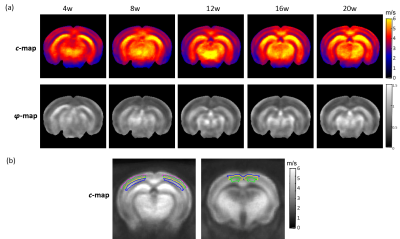 |
Molecular profiles underlying the fluid-solid transition of brain tissue during maturation: High-resolution multifrequency MR elastography of the mouse brain paired with proteomics mass spectrometry.
Jing Guo, Gergely Bertalan, Charlotte Klein, David Meierhofer, Shuangqing Wang, Stefanie Schreyer, Jürgen Braun, Barbara Steiner, Carmen Infante-Duarte, Ingolf Sack
We have investigated the mechanical development of the mouse brain from 4 weeks to 20 weeks by multifrequency MR elastography and performed proteomics analysis with mass spectrometry. Highly resolved elastographic atlases of brain maturation were generated and regional analysis was performed to identify areas with age-dependent changes in viscoelasticity. In hippocampus, molecular signatures associated with macroscopically observed mechanical profile were identified, suggesting a transition from a soft-fluid to a more elastic-solid state during maturation. Combining MRE and proteomic analysis, we provide structural and functional information related to brain maturation from the molecular level up to whole-organ mechanical scale.
|
| 14:21 |
1148.  |
Heritability of the mouse connectome
Nian Wang, Robert Anderson, David Ashbrook, Gary Cofer, Youngser Park, Carey Priebe, Joshua Vogelstein, Yi Qi, Robert Williams, G. Johnson
The human connectome project has demonstrated the enormous potential of functional and structural connectomics in understanding the brain. Extension of connectomics to mouse models has analogous potential, particularly where genetic variation can be controlled and manipulated. But the methods developed for human are not immediately extensible to the mouse models. We have developed a long term strategy, methods and infrastructure to make mouse connectomics routine with validation against tracer techniques. This project represents our first effort to deploy the methods in a study of heritability in a controlled collection of 4 genetically different strains.
|
14:33 |
1149. 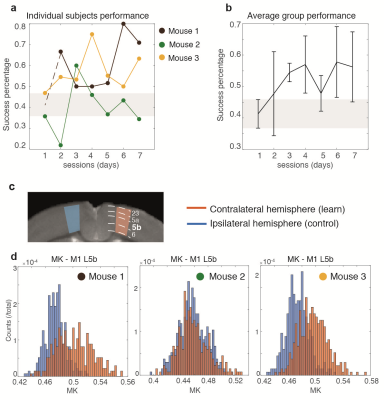 |
Learning-induced microstructural changes in specific layers of primary motor cortex revealed by diffusion kurtosis tensor imaging
Teresa Serradas Duarte, Rafael Neto Henriques, Daniel Nunes, Steven R. Zeiler, John W. Krakauer, Noam Shemesh
Motor skill acquisition is known to induce microstructural changes in the motor cortex grey matter, which yield the encoding of new motor memories. Whether such alterations can be measured with diffusion magnetic resonance imaging (dMRI) is still an open question. Here, diffusion kurtosis tensor imaging is used to detect specific layer changes ex-vivo in mice after learning a new lateralized motor prehension task. Mean Kurtosis (MK) was found to increase with learning in M1 layers 5b and 6. Such changes were not observed in non-task-related regions. Moreover, single subject MK distributions appear to correspond with behaviour performance.
|
14:45 |
1150. 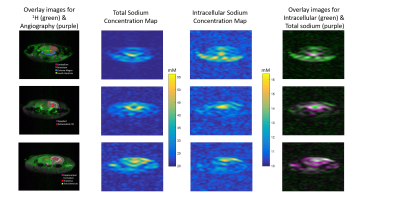 |
Triple Quantum Filtered Sodium Imaging at 21.1 T Reveals Dynamic Progression in a Preclinical Migraine Model
Nastaren Abad, Ghoncheh Amouzandeh, Jens Rosenberg, Michael Harrington, Samuel Grant
The brain allocates >50% of its energy reserves to the regulation of sodium homeostasis, indicating the critical importance of sodium and its fluxes in normal brain as well as neurological disorders. With the goal of localizing specific changes within intra- vs. extracellular compartments, this study utilizes Triple Quantum (TQ) coherence to evaluate 23Na fluxes in a preclinical rodent analogue of migraine. At a high spatial and temporal resolution, longitudinal scanning was performed at 21.1 T to quantify alterations in bulk and bound sodium during and following the onset of central sensitization.
|
| 14:57 |
1151. 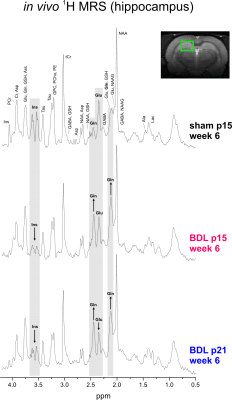 |
Chronic hepatic encephalopathy in early developing brain, neurometabolic changes differ depending on the age of disease onset, in vivo longitudinal 1H MRS study
Veronika Rackayova, Olivier Braissant, Valerie McLin, Cristina Cudalbu
Chronic hepatic encephalopathy (CHE) due to chronic liver disease (CLD) causes irreversible cognitive deficits in children. We aimed to study possible differences in neurometabolic changes in rat model of CLD&CHE depending on the age of the disease onset (post-natal day 15 vs 21), using in-vivo 1H-MRS. We showed differences in Gln, tCho, Lac, Asc, GSH and neurotransmitter concentrations between p15 and p21 pups during the evolution of the disease. These differences suggest that age of disease onset and its coincidence with neurodevelopmental processes play an important role and may result in different vulnerability to the disease depending on the age.
|
15:09 |
1152. 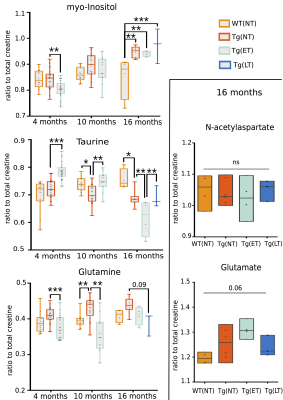 |
A longitudinal neuroimaging study of the effects of early versus late anti-inflammatory treatment in the TgF344-AD rat model of Alzheimer’s disease
Caitlin Fowler, Dan Madularu, John Breitner, Jamie Near
Alzheimer’s disease (AD) is a progressive neurodegenerative disorder with no effective treatments or known biomarkers for definitive diagnosis, substantiating the need for early detection and intervention. This project employs Magnetic Resonance Spectroscopy to measure neurochemical changes in the TgF344-AD rat model of AD in response to treatment with a common non-steroidal anti-inflammatory drug. Progression of neurochemical changes over time and in response to treatment are compared to behavioural measures of cognition and histopathology. Preliminary results suggest neurochemical changes are present before onset of cognitive impairment, and treatment response depends on whether treatment is administered early or late into disease progression.
|
| 15:21 |
1153. 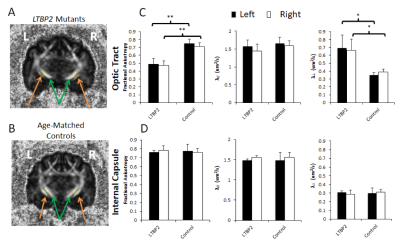 |
The Effects of Genetic Risk Factors for Glaucoma on the Visual Pathway using Diffusion Tensor MRI
Max Colbert, Yolandi Van der Merwe, Leon Ho, Xiaoling Yang, Gillian McLellan, Samual Hurley, John Fingert, Carlos Parra, Muneeb Faiq, Gadi Wollstein, Joel Schuman, Kevin Chan
Glaucoma is the second leading cause of blindness worldwide. To date, the cause of the disease is still unknown, yet a number of candidate genes for glaucoma have been recently identified. In this study, we evaluated the effects of some of these genetic risk factors on the visual pathway using diffusion tensor MRI in experimental animal models. We found that LTBP2 mutants in cats and DBA/2J mice had decreased fractional anisotropy and increased radial diffusivity in the visual pathway. DBA/2J mice also exhibited reduced axial diffusivity, whereas TBK1-transgenic mice did not show detectable DTI changes along the visual pathway.
|
| 15:33 |
1154. 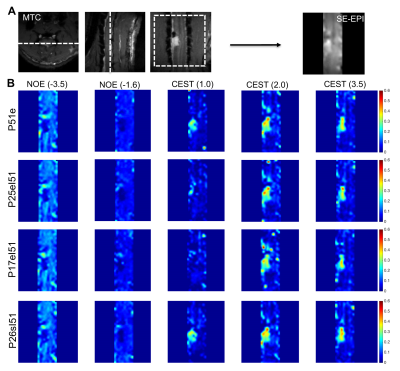 |
Rapid and Accurate CEST and NOE MRI of Injured Spinal Cord Using Multi-Pool Fitting
Feng Wang, Zhong-Liang Zu, Tung-Lin Wu, Xinqiang Yan, John Gore, Li Min Chen
This study aims to evaluate the accuracy of estimates of the amplitudes of specific CEST and NOE effects in Z-spectra derived from multi-pool fitting using down sampled data, and their sensitivity for assessing injury-associated changes in spinal cords of squirrel monkeys. An inverse subtraction analysis corrected for changes in the apparent water longitudinal relaxation rate R1obs (AREXmfit) was used to quantify regional spectra around lesion sites. The results provide an optimized rapid, sensitive, and accurate protocol for deriving both NOE and CEST effects in spinal cord imaging at high field.
|
 Back to Program-at-a-Glance |
Back to Program-at-a-Glance |  Back to Top
Back to Top